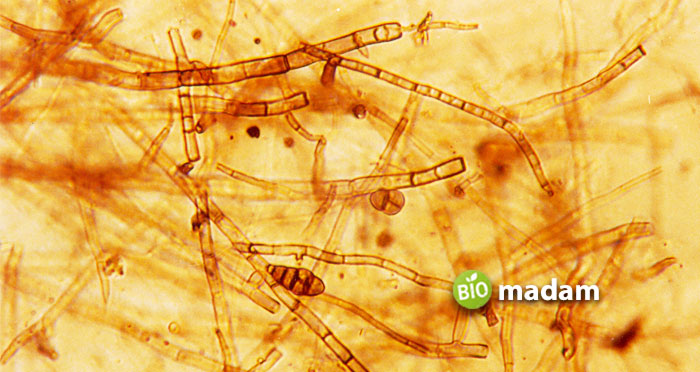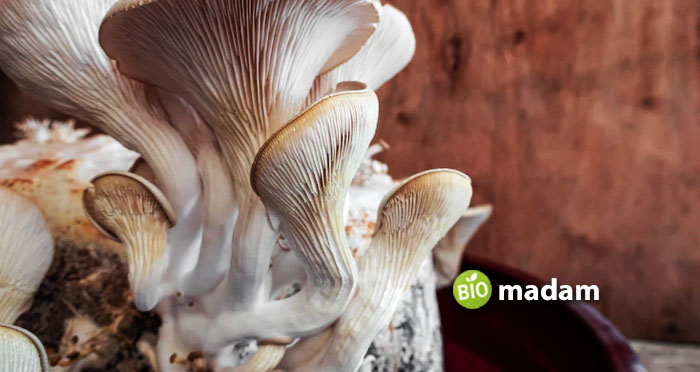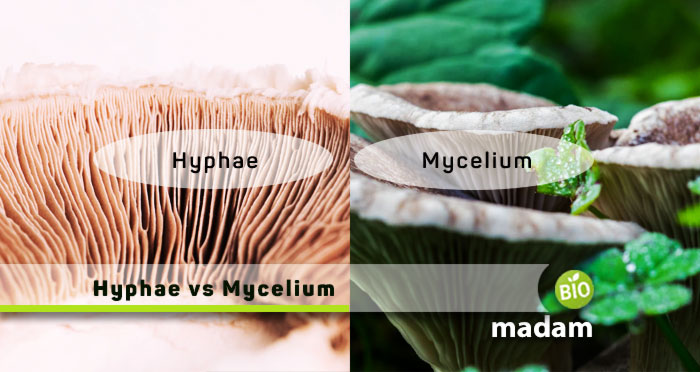Hyphae and mycelium are common terms associated with members of the kingdom Fungi, including fungus and mold. Fungi are an important part of food webs and food chains, acting as decomposers. Thus, studying their structure plays a major role in understanding their contribution to ecosystems and communities. Hyphae and mycelium are structural components of fungi, yet they differ in their morphology. Keep reading to learn the differences between hyphae and mycelium in fungi.
Comparison Table
| Characteristics | Hyphae | Mycelium |
| Definition | Filamentous parts of fungi | Building blocks of fungi |
| Types | Septate and aseptate | Homo and dikaryotic |
| Appearance | Threadlike | Patch of multiple threads |
| Morphological Significance | Filamentous part | Vegetative part |
| Functional Level | Micro | Macro |
| Growth | Through spitzenkörper | Asexual and sexual reproduction |
What are Hyphae?
Hyphae refer to the branching tubular cells of the fungi arranged end to end, resembling threadlike filaments. Hyphae are the main component of vegetative growth in fungal bodies and are the building blocks of fungi. The structure of hyphae within one group of fungi may also vary from each other.
Structure of Hyphae
Hyphae may comprise one cell or more protected by a chitin cell wall. Most fungal species contain hyphae that are separated by walls known as septa, while others do not. They are known as aseptate fungi. Septa have small pores in them that allow the transport of organelles between the hyphae cells. Organelles called spitzenkörper are present at the tip of the hyphae, which is a part of the endomembrane system that releases vesicles from the Golgi bodies. The movement of the spitzenkörper, along with the hyphae’s apex, exhibits growth. The apical growth rate depends on the movement of the spitzenkörper present at the tip.

Function of Hyphae
The long filaments of hyphae are not visible without a compound or electron microscope until they combine to form mycelium. They release enzymes that enable the function of fungi as decomposers. The hyphae in parasitic fungi form haustoria. The fungi-acting parasites on hosts obtain nutrients from the substrate using the haustoria. Actinobacteria and oomycetes also contain hyphae.
What is Mycelium?
Mycelium refers to a collection of hyphae that forms the body of multicellular fungus, that is one of the many eukaryotic cells. Varying groups of fungi have unique mycelia. Mycelium is categorized into multiple groups based on the texture, colors, secretions, growth pattern, and whether they are septate or aseptate.
Structure of Mycelium
The mycelium is composed of numerous hyphae, forming a spreading structure. This is the vegetative thallus of the multicellular fungi. The fusion of filamentous hyphae looks like a cotton ball found in or on the soil. The homokaryotic mycelium forms by spore germination, while two homokaryotic mycelia may fuse to give rise to dikaryotic mycelium. They contribute to sexual and asexual reproduction in fungi. Homokaryotic mycelium allows asexual reproduction, whereas dikaryotic mycelium facilitates sexual reproduction. Sexual reproduction leads to the formation of other fungi and fruits.
Function of Mycelium

Mycelium in fungi has a critical role in several types of ecology. Besides decomposition, they also have a role as biological filters to remove microbes from water.
Similarities Between Hyphae and Mycelium
- Hyphae and mycelium are important morphological structures in fungi.
- They give a threadlike appearance.
- Both are made of eukaryotic cells.
- Their cell walls comprise chitin.
Difference Between Hyphae and Mycelium
Definition
Hyphae
Hyphae are branching filaments that look like long threads and make up the mycelium.
Mycelium
Mycelium is the white vegetative part of fungi composed of multiple hyphae.
Types
Hyphae
Hyphae are categorized as septate and aseptate depending on the presence of septa.
Mycelium
While mycelium can be classified as homokaryotic and dikaryotic according to its structure and reproductive activity.
Appearance
Hyphae
Individual hyphae look like long threads, strands, or filaments.
Mycelium
Alternatively, mycelium looks like a patch or bunch of numerous strands of threads.
Morphological Significance
Hyphae
Hyphae are the filamentous part of the fungi that give rise to mycelia.
Mycelium
Whereas, mycelium is the vegetative structure in the fungal body that facilitates vegetative growth.
Functional Level
Hyphae
Hyphae are too small to be seen with the naked eye and function at the micro level.
Mycelium
On the contrary, mycelia function at the macro level, and you can see them when the hyphae are tightly packed together.
Growth
Hyphae
Hyphae grow with the help of small vesicles called spitzenkörper on the tip of the hyphae.
Mycelium
Conversely, mycelium grows through sexual and asexual reproduction.
The Bottom Line
Just like plants and animals, fungi are also essential organisms to the ecosystem. Hyphae and mycelium are vital to all fungi. They contribute to growth and reproduction in fungal bodies. Hyphae are the building blocks of fungi as they combine to form a mycelium. Morphologically, mycelium looks like a cotton ball on the substrate or soil. The main difference between hyphae and mycelium is their functional level. Hyphae are not visible to the naked eye, but you can see them under a student microscope. However, mycelium with tightly packed hyphae may be observed without a microscope.
FAQs
How does hyphae become mycelium?
Mycelia are formed by the fusion of hyphae that combine to assemble a macrostructure. New hyphae develop from the spores present on mycelia.
Can hyphae grow in humans?
Fungi acting as antigens and pathogens in the human body may grow in more than one morphological form in the body. A few of them develop filamentous hyphae during their lifecycle in the host.
Can bacteria grow hyphae?
While bacteria and fungi are not closely related, they live together in various biomes and ecosystems. Studies show that hyphae may contain bacterial parasites and act as a host for them. Common fungal hosts for viable bacteria include Eurotiomycetes, Dothideomycetes, Pezizomycetes, and Sordariomycetes.

Hello, I would like to introduce myself to you! I am Chelsea Rogers, an experienced blog writer for science articles, holding an MPhil degree. My enthusiasm to grab the best knowledge, let it relate to botany, zoology, or any other science branch. Read my articles & let me wait for your words s in the comment section.

